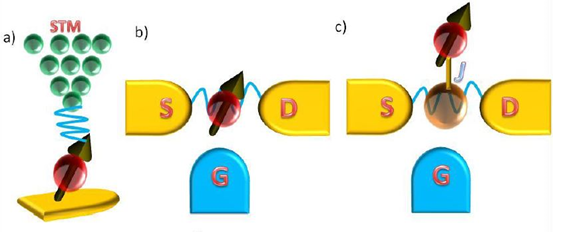Spintronics
The contemporary evolution of “spintronics” revolutionized the electronics. Until recently, in standard electronics only electrons are manipulated and send through different device
components to transport, read or write information. But only the charge of the electrons was considered and spin of the electrons was ignored in mainstream charge-based electronics.
In spintronics, it is not the electron charge but the electron spin that is manipulated. Spintronic systems exploit the fact that the electron current is composed of spin-up and spin-down
carriers, which carry information encoded in their spin state and interact differently with magnetic materials. Information encoded in spins persists when the device is switched off, and
can be manipulated without using magnetic fields.
The key point is the creation of molecular spintronic device (molecular junction device) using magnetic molecules. Compounds of the single-molecule magnet (SMM) class seem particularly
attractive because their magnetization relaxation time is extremely long at low temperatures, reaching years below 2 K. These systems, combining the advantages of the molecular scale
with the properties of bulk magnetic materials, look attractive for high-density information storage and also, due to their long coherence times for quantum computing. Also, SMMs
have a certain chemical characteristic to overcome various problems associated with junction device. As they contain an inner magnetic core surrounded by organic ligands that can be
tailored to bind with the junction. SMMs often have delocalize bonds which can increase the magnetic interactions between the magnetic core ions and enhance the conducting properties.
SMMs are available in different shape and size and coupling of magnetic molecules to the environment can be altered easily.
Till to-date various possible spintronics devices are constructed based on SMMs and MNMs (molecular nanomagnets) and they fall mainly into the following
three categories (a) Molecular spin transistors (b) Molecular spin-valves (c) Molecular multidot devices. Basics of these devices and how they function
are described below.
Molecular Spin Transistors
In molecular spin transistors, the magnetic molecules are attached between two non-magnetic electrodes. The first possibility is to attach a magnetic molecule between two electrodes
(a two terminal molecular junction device), Fig.1. Another way is to employ Scanning tunnelling microscope (STM) tip as an electrode to study molecules adsorbed on surfaces, Fig.2.
The second possibility involves a three terminal molecular spin transistor where MNMs are attached to two non-magnet leads and in addition there is also a gate electrode. Here the
current pass through the molecule from source to drain and electronic transport are fined tuned using a gate voltage Vg. Since the electrons are passing through the molecule in this
setup, this leads to strong coupling between the electrons and the magnetic core. This is called direct coupling and this enables one to read out the magnetic properties of the
molecules using the electronic current. However strong influence on the magnetic properties of the molecules are expected in this approach.

Fig. 1. Two terminal molecular junction device. Magnetic molecule is attached to gold electrodes through Au-S linkage.

Fig. 2. Schematic representation of different device geometries for molecular spintronics a) Molecule on Au (111) studied using STM tip b) Three terminal spin dot device with direct
coupling to the leads c) three terminal double dot device where magnetic molecules are coupled to diamagnetic dot (indirect coupling).
Molecular Spin-Valve and Multidot Devices
A molecular spin valve (SV) is similar to a spin transistor but contains at least two magnetic elements. In spin valve, either a diamagnetic molecule is sandwiched between two magnetic
leas or a magnetic molecule which contains two magnetic centres attached to diamagnetic electrodes. SVs change their electrical resistance for different mutual alignments of the
magnetisations of the electrodes or magnetic centres (in case of diamagnetic electrodes) like polarizer-analyser set-up. Non-molecular devices are already used in hard-disk drives,
owing to the giant- and tunnel-magnetoresistance effects. Giant magnetoresistance (GMR) is also observed when SMMs having a magnetic centre are adsorbed on a surface like carbo nanotube
or graphene sheet and connected to two diamagnetic leads.
The molecular multidot devices expand the scope beyond the spin-valve where transport measurements are expected to be controlled by a number of molecules. Only one experiment, up to now,
has considered the chemical fabrication of multidot devices, obtaining a controlled sequence of CdSe QDs connected by p-benzenedithiol molecular bridges, in a process reminiscent of the
solid-phase synthesis of peptides. Experimental studies reveal coherent spin transfer through the bridges and demonstrate the possibility of building such devices. Again SMMs are of
great interest here as they could be functionalized and attached to the non-magnetic bridge such as carbon nanotube or lanthanide encapsulated fullerene placed on carbon nano tube could
be ideal.
In case of molecular spin transistor, when the bias voltage is applied, the spin of the magnetic centre can interact with the electron moving from source electrode to drain electrode
which causes the filtering of current by allowing either alpha or beta electron and is called spin filtering effect.